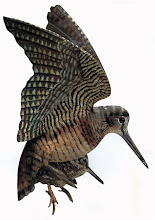
In our third project, 2008, we deal with two prototypes given by Microwave Telemetry Inc. One of the prototypes is used by Araba.
On March 10th, 2008, the woodcock Araba was caught in Lukiano (Araba, Basque Country). Araba is male, young, his weight 335 grams.
On March 10th, 2008, the woodcock Araba was caught in Lukiano (Araba, Basque Country). Araba is male, young, his weight 335 grams.
Araba went up to the surroundings of Rantala in Suojarvi, Republic of Karelia, travelling around 3,280 km.
From September 14th on, in all the different emissions the activity sensor has not changed: so, the bird is dead and/or his PTT is detached.
Some conclusions:
a) Speed of flight
On April 26th, Araba in his way from Germany to Sweden crossed the sea at night (from 20:18 to 21:56, UTC) given two emissions to travel 108 km. So, his speed of flight was 66 km/h.
b) Resting periods
Araba was resting in Sweden two days.
c) Duty cycle
b) Resting periods
Araba was resting in Sweden two days.
c) Duty cycle
This new PTT has a special duty cycle of 55/8. Taking into account the data from our previous two projects and the data from this project, here some clear consequences of the use of this new technology during 2008:
(1) The charge of the PTT has been greater than in our previous experiments.
(2) In each emission per day, Argos has given more locations this year than in the previous two years.
(3) The emissions’ data given by Argos have been much better in quality and quantity.
(4) The frequency of the emissions has been more regular than in the two previous projects.
(5) The frequency has been broken only in very few occasions, when clearly there were no interference problems. So, as hypothesis, we have tried to link this phenomenon with the woodcock’ roding or croule.
(6) The problem of the interferences has been overcome with high charge, as we proposed in our previous experiments.
d) Roding or croule
Araba has been ‘missing’ during some few days, when it was in Araba (Basque Country) and in the breeding zone. Was it roding? Mating females?
Can be related those missing days to mating after roding? It is really difficult to give a right answer, but we have tried to see all these ‘missing’ days, and, as hypotheses, tried to relate those data with possible mating periods .
e) Interferences
(2) In each emission per day, Argos has given more locations this year than in the previous two years.
(3) The emissions’ data given by Argos have been much better in quality and quantity.
(4) The frequency of the emissions has been more regular than in the two previous projects.
(5) The frequency has been broken only in very few occasions, when clearly there were no interference problems. So, as hypothesis, we have tried to link this phenomenon with the woodcock’ roding or croule.
(6) The problem of the interferences has been overcome with high charge, as we proposed in our previous experiments.
d) Roding or croule
Araba has been ‘missing’ during some few days, when it was in Araba (Basque Country) and in the breeding zone. Was it roding? Mating females?
Can be related those missing days to mating after roding? It is really difficult to give a right answer, but we have tried to see all these ‘missing’ days, and, as hypotheses, tried to relate those data with possible mating periods .
e) Interferences
It is true that there are interferences around the Mediterranean Sea. In our two previous projects there was no way to localize the birds in different places of Europe and during long periods of time.
It is clear that MTI and Argos did know that problem. This is why Paul Howey (of MTI) wanted to check two prototypes in Europe and with woodcocks:
(i) To know whether the prototype charge better or not.
(ii) To know if the new PTT charge well with such a special bird as the woodcock is (moving in special spaces, traveling at night, and so on).
(iii) To know the performance of the new PTT against the European interferences. (We do know that in order to overcome the interferences the PTT’s charge is the main variable.)
(ii) To know if the new PTT charge well with such a special bird as the woodcock is (moving in special spaces, traveling at night, and so on).
(iii) To know the performance of the new PTT against the European interferences. (We do know that in order to overcome the interferences the PTT’s charge is the main variable.)
The final result is net: the European interferences have been overcome with the new PTT, during all the time the tracking lasted and in all the different atmospheric circumstances.
Is it possible to gather even more data? To gather even more accurate data? We will keep working, researching, trying to know more about the migration of the Scolopax rusticola and to gather data with more frequency and better accuracy, always following the advices of MTI.
Is it possible to gather even more data? To gather even more accurate data? We will keep working, researching, trying to know more about the migration of the Scolopax rusticola and to gather data with more frequency and better accuracy, always following the advices of MTI.
For more information, see Scolopax rusticola without frontiers: http://www.euskonews.com/0522zbk/gaia52202en.html. See also Scolopax rusticola without frontiers: Araba from the Basque Country to Karelia, paper to be presented at the 5th International Symposium DYNAMICS OF GAME POPULATIONS IN NORTHERN EUROPE, Rabocheostrovsk, Republic of Karelia, Russia: http://es.scribd.com/doc/58456582/Scolopax-rusticola-without-frontiers-Araba-from-the-Basque-Country-to-Karelia.
Last note: Araba’s PTT was recovered in Rantala, region of Suojarvi, Karelia in September, 2009. See The recovery of Araba’s PTT in Karelia: http://es.scribd.com/doc/58456686/The-Recovery-of-Araba-s-PTT-in-Karelia.
